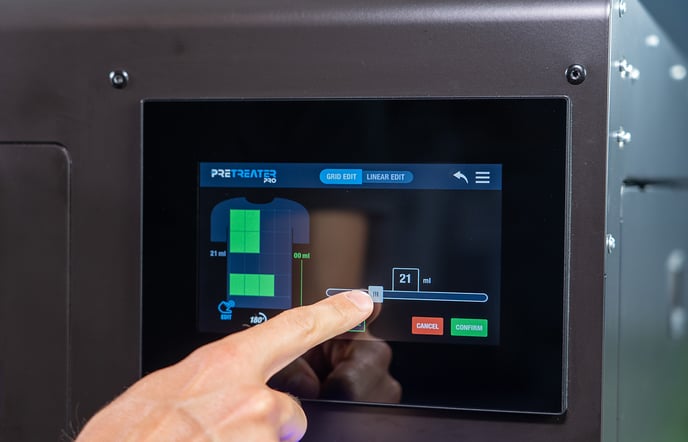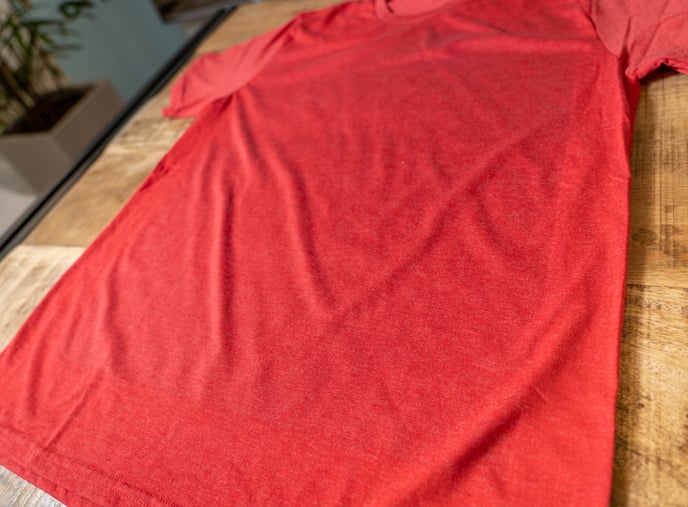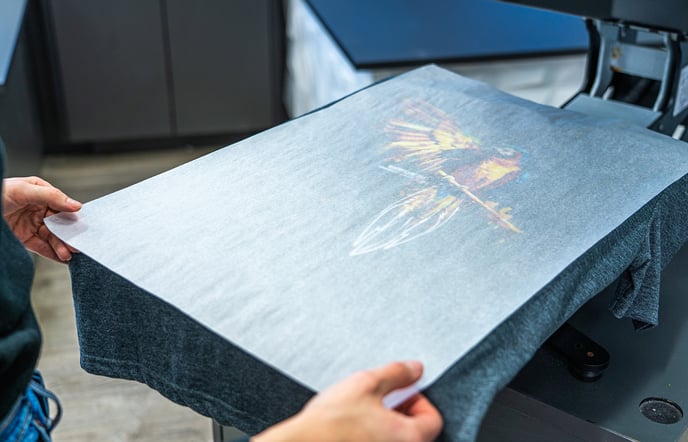Common practices that attribute to the pretreatment staining phenomenon and solutions that will help you surpass it.
Sometimes, after spraying the pretreatment solution on the fabric and proceeding to curing it in a heat press, visible imperfections (e.g. stains) emerge on the garment’s surface. The frequency of this phenomenon is more evident in dark and black colored fabrics, since their dye makes the stain more detectable. In some cases, the stains appear in random areas of the cured fabric like spots and in others, like a box shaped stain around the perimeter of the fabric, where the limits of the heat presses' surface are.
There is a number of possible reasons for the cause of these imperfections, hence we will examine them one-by-one and provide solutions on how to overcome them.
Pretreatment quantity
 Applying an overload of pretreatment is the most common cause that leads to the formation of stains. If more pretreatment is applied to the fabric than the amount that is actually required, then after the fixation, the surface of the fabric will be covered with a thick rigid white layer. This is mainly due to the polymeric ingredient that the pretreatment liquids contain, which in high temperatures transitions from a viscous fluid to a rigid plastic film. This is why it is important to spray the right amount of pretreatment, a factor that of course depends on the fabric’s type, its thickness and the use that it is destined for. For example, a garment that contains polyester is more likely to stain as opposed to a cotton one and thinner garments usually require less pretreatment than thicker materials.
Applying an overload of pretreatment is the most common cause that leads to the formation of stains. If more pretreatment is applied to the fabric than the amount that is actually required, then after the fixation, the surface of the fabric will be covered with a thick rigid white layer. This is mainly due to the polymeric ingredient that the pretreatment liquids contain, which in high temperatures transitions from a viscous fluid to a rigid plastic film. This is why it is important to spray the right amount of pretreatment, a factor that of course depends on the fabric’s type, its thickness and the use that it is destined for. For example, a garment that contains polyester is more likely to stain as opposed to a cotton one and thinner garments usually require less pretreatment than thicker materials.
Tip:
- The recommended pretreatment amount for a 40cm x 60cm (15.7"x23.6") area , when pretreating dark cotton (150 gr/m2 t-shirt) with the Texjet Inks - Pretreatment for Darks liquid, is about 21 to 25 ml. When printing on light cotton is 14 ml and on light polyester about 20 ml of the Texjet Inks - Pretreatment for Darks solution.
Pretreatment uniformity
Spot stains may be the result of an uneven sprayed pretreatment solution. This phenomenon is most likely to happen when using a hand sprayer, which makes it quite difficult to know the exact amount of pretreatment sprayed. If you pretreat the fabrics only manually, you should try to apply the solution as equally as possible. Use the same direction, when spraying, and don’t overlap the already sprayed areas too many times. This could lead to some areas being overly pretreated and others having less pretreatment than required, which would cause an uneven print with patches. A foam roller can help spread the pretreatment equally onto the fabric and improve uniformity. It should be handled with gentle strokes and not harsh scrubbing as this would take away some of the pretreatment and create wrinkles on the surface of the fabric.
Equipment, such as an automatic pretreating machine like the PreTreater Pro, may prove valuable in such cases, as it sprays exactly the amount of pretreatment needed, plus it provides uniformity.
Heat & Pressure

Most pretreatment liquids are fixated for 30 seconds at temperatures around 160-170 oC (320-338 F). If the temperature rises then the polymeric ingredient contained in the solution, which is basically plastic, will burn causing visible spots in the fabric. Even if the temperature is stable, but the precoated fabric remain too long under heat, the same result will be obtained.
Also, you should maintain pressure at medium levels. The use of high pressure will crush the liquid’s particles in the fabric’s surface causing visible white stains. A trick that is used often is the hover option that most heat presses offer. After pretreating the fabric, hover the press for a few seconds in order to give time to the liquid absorb into the fibers. By doing this, you avoid trapping the solution’s particles in the surface and at the same time allow some of the humidity to escape.
Learn more about Inks & Pretreatment Liquids: Fixation times and temperatures
Protective sheet paper

During the fixation of the pretreatment solution it is essential to use protective paper. Pressing garment after garment, a bit of pretreatment will stick to the heat presses’ surface each time, starting to build up and may, accidentally, be applied onto the next garment, causing stains and some “halo” effects. This is the reason why it is important to use protective paper on top of the fabric’s surface prior to pressing, so that the sprayed area won’t come in direct touch with the hot surface.
We suggest using disposable sheet paper, instead of Teflon sheets, as this type gives the best uniformity in drying and enables better evaporation of volatiles. These sheets should be used only a few times and then should be disposed off, in order to avoid the pile up of residue on the sheets, which can lead to staining. Teflon sheets tend to have higher amount of residue and trap moisture easier.
Crystallization
This phenomenon occurs when moisture is trapped in the heat press. In general, pretreatment solutions consist of 3 main ingredients. A polymer, salt and water. So, basically, the white stains that you see are crystals and are a result of the salt sitting on top of the fabric. This is because the water contained in the pretreatment solution evaporates and is trapped inside the heat-press. In this case, it is best to hover the fabric and let it dry a bit before pressing it. That will significantly reduce the possibility of crystallization. Alternatively, press the garment for 10 seconds, lift the heat-press for 5 seconds to let excess steam out and repress until you reach the recommended curing time.
Also, very high pressure keeps the moisture trapped while very high temperature makes the water evaporate more quickly.
Lastly, when using a heat press, choose thin parchment paper instead of thick Teflon sheets that trap water easier. It is very important to choose a heat press that has an efficient system to let all the vapor out. If the crystallization still occurs, check the fabric you are using. It is possible that the fiber's weaving tend to trap more moisture than other fabrics.
-1.png?height=120&name=Polyprint%20Logo%20(Dark)-1.png)